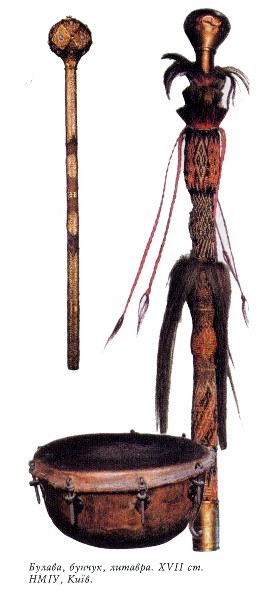Regalia
Regalia. Emblems, symbols, or paraphernalia of power or office. Archeological finds in Ukraine show that stone maces and axes were used as signs of power in the Stone Age. In the Princely era, family coats of arms served as regalia, those of a princely house usually including a trident of some kind. Standards (bunchuky) and flags were used widely, but the bulava was rare.
In the Cossack period, flags, bulavy, bunchuky, seals, litavry, bugles, and staffs with silver balls signified various offices of the Zaporozhian Sich and the Hetman state. The bulava was used by the hetman, and the pernach by colonels, from the 16th century. Bohdan Khmelnytsky received a silver bulava from the king of Poland, the Turkish sultan, and the Russian tsar. The bulava was also a sign of the Zaporozhian otaman’s authority. From the Zaporozhian Sich it was passed on to the Kuban Cossack Host, and was used by them until Soviet power was established in the Kuban.
The bunchuk, a distinctive standard of Turkish origin, consisted of a wooden staff with a decorative metal head, to which tasseled cords and one or more bundles of horsehair were attached. According to Cossack tradition, in 1578 Stephen Báthory presented the Cossack hetman with a bunchuk and other regalia. The bunchuky carried by hetmans had red horsetails and white-and-black cords.
Cossack banners were usually made of carmine cloth with images of saints, crosses, and coats of arms embroidered on them. They were carried on each side of the hetman or otaman at the head of the Cossack army. The litavry were large copper kettledrums used for announcing various solemn events. The Russian tsars presented the Cossack hetmans and the Zaporozhian Host with various regalia.
In the Ukrainian church the chief regalia are the miter, panagia, and crosier. The miter has been used since the 11th century. Shaped at first like a crown, it evolved to a high, pointed hat with enamel medallions on the sides. Originally worn by bishops, by the end of the 12th century the miter was bestowed on archimandrites and distinguished clergymen. The panagia is a round metal icon of the Holy Mother on a chain that is worn on the breast by Orthodox prelates and archimandrites of stauropegion monasteries. The crosier (posokh or zhezl) is presented to a hierarch at his consecration. It is topped with a metal cross.
Mykhailo Miller
[This article originally appeared in the Encyclopedia of Ukraine, vol. 4 (1993).]

.jpg)
